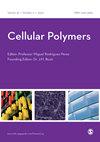PBAT对PBS/PBAT泡沫物理、形态和力学性能的影响
IF 1.3
4区 医学
Q4 MATERIALS SCIENCE, BIOMATERIALS
引用次数: 18
摘要
本研究考察了聚己二酸丁二酯(PBAT)含量对聚丁二酸丁二酯(PBS)/PBAT泡沫的物理、形态和力学性能的影响。以化学发泡剂偶氮二甲酰胺和交联剂过氧化二氨基苄酯为原料,采用压缩成型技术制备了PBS/PBAT泡沫塑料。利用傅里叶变换红外和扫描电镜技术分别检测了PBS/PBAT泡沫的化学结构和形态性能,并利用万能试验机研究了拉伸和弯曲性能。结果表明,PBAT的加入几乎没有提高PBS/PBAT共混物的粘度,仅对PBS/PBAT泡沫的平均孔大小产生微小的变化。然而,PBAT含量的增加对PBS/PBAT泡沫的柔韧性和韧性有相对显著的改善,与PBS泡沫相比,PBS/PBAT泡沫的杨氏模量和抗拉强度有所降低。与拉伸结果相似的行为被注意到的是整齐和PBS/PBAT泡沫的弯曲性能。本文章由计算机程序翻译,如有差异,请以英文原文为准。
Effect of PBAT on physical, morphological, and mechanical properties of PBS/PBAT foam
This study examines the effect of poly(butylene adipate-co-terephthalate) (PBAT) content on the physical, morphological, and mechanical properties of poly(butylene succinate) (PBS)/PBAT foam. A compression molding technique was used to prepare the PBS/PBAT foam using the chemical blowing agent azodicarbonamide and the cross-linking agent dicumyl peroxide. The chemical structure and morphological properties of PBS/PBAT foam were examined via Fourier transform infrared and scanning electron microscopy techniques, respectively, whereas tensile and flexural properties were investigated using a universal testing machine. The results reveal that the incorporation of PBAT barely enhances the viscosity of the PBS/PBAT blend, producing only minor changes in the average cell size of PBS/PBAT foam. However, increasing the PBAT content contributes to a relatively significant improvement in the flexibility and toughness of PBS/PBAT foam, where a decrease in Young’s modulus and tensile strength of the PBS/PBAT foam is observed compared with those of the PBS foam. Similar behavior to the tensile results is noticed for the flexural properties of the neat and PBS/PBAT foams.
求助全文
通过发布文献求助,成功后即可免费获取论文全文。
去求助
来源期刊

Cellular Polymers
工程技术-材料科学:生物材料
CiteScore
3.10
自引率
0.00%
发文量
9
审稿时长
3 months
期刊介绍:
Cellular Polymers is concerned primarily with the science of foamed materials, the technology and state of the art for processing and fabricating, the engineering techniques and principles of the machines used to produce them economically, and their applications in varied and wide ranging uses where they are making an increasingly valuable contribution.
Potential problems for the industry are also covered, including fire performance of materials, CFC-replacement technology, recycling and environmental legislation. Reviews of technical and commercial advances in the manufacturing and application technologies are also included.
Cellular Polymers covers these and other related topics and also pays particular attention to the ways in which the science and technology of cellular polymers is being developed throughout the world.
 求助内容:
求助内容: 应助结果提醒方式:
应助结果提醒方式:


